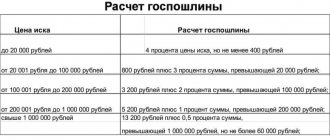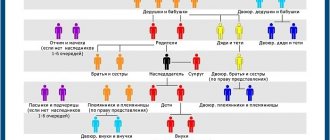In almost every person’s life there comes a time when they need to accept an inheritance (property). Let's try to understand the existing types of inheritance, who is entitled to it? Who has the right to claim it? Who is not entitled to this right? You will learn about all this and other equally important points about inheritance from this article.
Relatives having the right of inheritance by law
Inheritance by law is considered to be the receipt of an inheritance after the death of a citizen, which is carried out in accordance with the normatively established procedure without changes made by the legislator. In this case, the rights and obligations of the previous owner pass to the heirs in the order clearly established by the Code.
In such a situation, certain types of inheritance are regulated by law in Articles 1142 to 1145. According to these norms, the children, spouse and parents of the testator are considered the first priority heirs.
If there are no heirs of the first stage, then the property is transferred to the heirs of the second stage: brothers, sisters, grandparents. Moreover, the fullness or partiality of the relationship does not matter, as well as whether the relatives are from the father’s or the mother’s side. Types of inheritance in the Russian Federation, according to the law, determine third-line heirs in the absence of the above steps: uncles and aunts of the testator.
The absence of relatives listed above determines the further path of the property, which is transferred to the heirs of the 4th and 5th degree of kinship. As a rule, such persons include great-grandparents, children of nephews or nieces, great-uncles and grandmothers, great-uncles and aunts. In the absence of all of the above categories of persons, the stepdaughter, stepsons, stepmother or stepfather will inherit as the last line - this is the last category, which is referred to as certain types of inheritance by law.
Step-by-step instructions on how to take possession of property after death without a will
There is an established procedure for entering into inheritance.
General algorithm of actions
To enter into an inheritance, you must adhere to the following order:
- Prepare the necessary documents.
- Submit an application to a notary.
- Appraise the property.
- Pay the state fee.
- Visit the notary again.
- Obtain a certificate of inheritance.
- Register the property.
State duty and deadlines
It is necessary to enter into inheritance rights within six months after the death of a brother or sister. If the death is established by the court, the period will be counted from the date indicated in the court decision or from the moment it enters into force.
As for expenses, the heirs must pay for the assessment of the property they receive. This is an important point, as it will determine the amount of all costs. The cost of the appraisal will depend on the property being appraised and the specific organization. Thus, an apartment appraisal will cost on average 3,000 rubles, a car – 2,000-5,000 rubles.
Also paid:
- State duty. It is 0.3% of the value of the inherited property, but not more than 100,000 rubles. If a person cannot prove the existence of a family connection, he will have to pay 0.6%.
- Notarial services. The amount will depend on the region. Taking into account the family connection, it does not change. When a notary leaves the office, the rate will increase 1.5 times (Article 333.25 of the Tax Code of the Russian Federation).
- Registration of property rights. Registration of an apartment costs 2,000 rubles, and in order to register the land for running a personal subsidiary, you need to pay 350 rubles.
If you need proof of the fact that you are dependent on the testator, you need to go to court. Since the hearing of the case will take place as part of a special proceeding, the fee will be 300 rubles. (Article 333.19 of the Tax Code of the Russian Federation).
Documentation
The list of required papers will be determined by the type of property you inherited. Basic documents include the following:
- identification document of the applicant;
- death certificate of the testator (if the court declared him dead, the original procedural document is additionally attached);
- documents confirming relationship with the deceased;
- certificate from the place of residence of the deceased;
- title documents for property;
- technical documentation for real estate;
- extract from the Unified State Register of Real Estate;
- confirmation of payment of state duty;
- property valuation report.
When opening an inheritance case at the request of another heir, most likely, a smaller package of documents will be required. A more detailed list should be checked with a notary.
Drawing up an application
The application is written in accordance with a specific form. It indicates the notary you contacted, notes the name and place of residence of the applicant, the date of death of the testator, his full name, the composition of the inheritance and the place where it is located, as well as the amount of the assessment.
At the end, you must write down that you accept the specified inheritance and ask for a certificate to be issued for it. Also, if available, the application indicates the heirs of the first priority and under the will. At the end there is a date and signature of the applicant. The notary can provide a sample application or draw it up himself.
We have other materials about the ladder of kinship in inheritance. Read articles about the third priority according to the law, about the order of nephews and grandchildren.
Inheritance by law: the real state of affairs
One of the powers that types of inheritance have in civil law is the right to transfer one’s property mass, based on the interests of the testator himself. However, despite the advantageous opportunity to dispose of one’s belongings independently even after death, inheritance by will is significantly inferior to the process of transferring property by law. If we consider the types of inheritance in the Russian Federation with examples, for example, by studying court decisions, we can see a close relationship between legal heirs and transferred property. In addition, there are the following objective reasons for this trend:
- Lack of a will as a document with legal force.
- The testator transfers only part of his rights and obligations without indicating the transfer of remaining powers.
- Invalidity of the will.
- Refusal of the heir to accept the inheritance.
- Death of an heir and absence of a person succeeding the deceased.
How to refuse in favor of someone?
Situations often occur when one of the heirs refuses property. However, it is possible to refuse inheritance. This means that the received share will be proportionally divided among other claimants to the property.
Along with the above options, there is the possibility of dividing property by agreement. Read about it on our portal. In addition, we recommend that you familiarize yourself with the materials on inheritance taxation and the rules for dividing property between third-line applicants, as well as the grandchildren of the deceased.
If in the near future you intend to enter into legal rights to the right to own real estate, then you should carefully consider a number of nuances. It depends only on you how the procedure for acquiring rights will work out.
It is quite possible that prudence will be an excellent help in ensuring that you become the owner of real estate both by law and by the will of your second-degree relatives. We wish you success in your further actions aimed at legitimizing your property rights in relation to the testator's property.
The relationship between the concepts of “disability” and “dependency” in inheritance law
The types and types of inheritance under consideration involve concepts such as “disability” and “dependency,” which at first glance seem similar, but have significant differences.
Disability occurs due to reaching a certain age:
- 55 years for women;
- 60 years for men.
In addition, it is present in citizens under 16 years of age (students under 18 years of age). Disability can also be caused by health conditions (disabled people of groups I, II or III).
If one of the above grounds is present, it does not matter whether the citizen is assigned a pension or does not have one. It is important to note that the types of inheritance that briefly characterize the categories of possible heirs do not include disabled people: pensioners who received such status through service, for example, employees of the Department of Internal Affairs, the Federal Penitentiary Service, miners, dancers, and so on. On the other hand, working after reaching retirement age does not deprive a person of the status of a disabled person.
Determination of dependent status
The concept of a dependent presupposes the presence of persons who are fully supported by the testator or who received assistance from him, which served as the only means of subsistence. As a rule, dependents actually acquired the status of a family member of the deceased. It is worth noting that irregularly received financial assistance is not a basis for obtaining dependent status. There is also no provision in civil legislation on the mandatory cohabitation of the testator and the person receiving the means of subsistence.
Based on the foregoing, a dependent is a person who, regardless of the presence and degree of relationship, received regular financial assistance from the testator, which was the main and irreplaceable source of funds necessary for existence, regardless of joint place of residence. When dependent, categories such as health status and actual age are not taken into account.
Inheritance by right of representation
The right of representation is one of the institutions that includes common inheritance. The concept, grounds, types of inheritance by right of representation are reflected in the 1140th articles of the Civil Code of the Russian Federation.
This legal category gives the children of an heir by law who died before the opening of the inheritance the right to claim the property of the deceased. Heirs in succession who are exempt from this right by the testator himself are deprived of inheritance by nomination. The children of a deceased heir do not inherit if there were grounds for deprivation of inheritance by law, for example, an attempted murder of the testator.
Who can be the heir
The first type of transfer of property from the deceased to his heirs involves the following potential successors:
- a relative of any age, a child conceived before the death of the testator, but born after it;
- state - provided that the inheritance is recognized as escheat.
If we consider the second type of transfer of real estate or movable property, the list of potential heirs will be wider. It includes individuals and legal entities, rural and urban settlements, and various international organizations.
The types of heirs are fixed in legislative acts in order to reduce conflict in the event of an inheritance dispute.
Types of inheritance: by will
Certain types of inheritance are becoming increasingly popular. The role of a certified document on the transfer of property after death cannot be overestimated, since inheritance by will allows you to:
- Determine the future fate of the hereditary mass.
- Bequeath to a person all your property or divide it into shares.
- Do not limit the circle of heirs chosen by the testator within the framework of the law.
- There is the possibility of bequeathing property to the state and public organizations.
- If you wish, you can exclude one or all heirs from the will.
It is worth noting that, while repeatedly mentioning the concept of “will” in the norms, the legislator did not give a clear definition of this term. In this regard, the doctrine of civil law gives the following definition: a will is a unilateral transaction representing the personal disposition of a citizen in the event of death. A will is aimed at distributing the property mass among those persons whom the testator has endowed with the status of heirs. It can be done either orally or in writing. This document must be certified by a notary.
Distribution of inherited assets among priority successors
It is legally established that the remaining savings are divided among all representatives of the 1st stage in equal shares. But depending on the type of followers and the type of ownership, other decisions can be made:
- When the testator's spouse is among the applicants, his share in the joint matrimonial property is first allocated, since it is not divided, but remains in his possession. The other part belonging to the deceased is subject to division by the remaining relatives, which includes the surviving spouse;
- The share of a descendant who has the powers of a representative is divided among his successors in equal parts. Depending on the number of descendants, the size of the share will be determined. For example, when there are two of them each receive half, three - 1/3, etc.;
Regardless of the rules for determining the size of shares established by law, successors have the right to themselves determine the sequence of distribution of inherited property and their size by concluding a joint agreement.
If agreement cannot be reached, division may be carried out in court.
- Indivisible property, representing things that cannot be divided without causing harm to their integrity. If such an object is transferred into personal possession, then only one applicant can purchase it. Such an action entails the collection of material compensation in favor of other participants in the procedure;
- Personal property of the deceased. Values are distributed among successors in the form of shared, joint and other ownership.
Procedure for notarization of a will
The special procedure for certifying a will by a notary is characterized by the following features:
- One of the duties of a noatrice is to establish the identity of the testator after viewing his documents (passport, driver’s or service license), and verify the person’s legal capacity.
- During the certification procedure, the provisions of the law on compulsory share must be explained to the testator, about which a note is made in the will.
- The completed will is signed by the testator under the supervision of a notary, after it has been read aloud to him.
- A notary has no right to sign a will that contains crossed out words, blots, corrections, additions, as well as documents written and signed in pencil. All names mentioned in the text must be written in words, without any abbreviations.
- The notary does not certify wills drawn up in his name.
Forms of deprivation of inheritance
The forms of depriving an heir of the rights to dispose of the inherited mass are as follows:
- Deprivation of the right to inherit by direct reference to those persons who, after death, will not be able to receive an inheritance.
- Deprivation of inheritance by delineating a strictly defined circle of persons as heirs, that is, keeping silent about any of the applicants.
However, along with the opportunities provided to deprive heirs of the legal status, the legislator established the impossibility of depriving close disabled relatives of property. In addition, Art. 1149 of the Civil Code names a list of relatives who claim a legal share of the inheritance.
Escheat
Such according to Art. 1151 of the Civil Code recognizes the property of the deceased if there are no applicants for its receipt (both testamentary and legal). The reasons for the latter: there were no successors initially, they wrote a declarative refusal to receive the inheritance, they were removed from this process in the format of the law (the status of unworthy heirs was assigned).
In this situation, movable, immovable property and other assets are transferred to the benefit (treasury) of the entity in which they are registered/located. If there is no connection to the subject (for example, there was intellectual work and dividends from it), then the transfer is carried out to the budget within the boundaries of the law of the Russian Federation.





